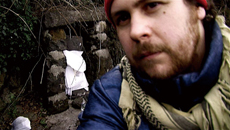|
| |
 |
|
| ▲ Karikis at Artspace C, owner Ahn Hyekyoung, with works by Jeju artists Yang Mi-kyoung (haenyeo painting) and Kim Young-hun (dongjaseok sculpture). Photo by Anne Hilty |
Jeju has long identified as an island of artists. But how have foreign artists viewed and portrayed Jeju Island — in literature, visual art, and architecture?
J.M.G. Le Clezio, a French-Mauritian writer and 2008 recipient of the Nobel Prize in Literature, published a three-part article about the island in GEO magazine (French edition, March 2009).
| |
 |
|
| ▲ J.M.G. Le Clezio wrote about Jeju in GEO magazine. Photo by Kang Jung Hoon |
Le Clezio wrote about both the nature and culture of Jeju, including a mid-20th century period of trauma. He captured a significant feature of this small island society when he wrote, "This tale, simultaneously touching and appalling, is part of the spirit of Jeju, of the philosophy both sad and full of the spirit of life that impregnates this island," further depicting Jeju as a place of "ghosts and spirits" and "an island of emotion rather than a land of certitude."
Paul Yoon, a Korean-American author, also portrayed Jeju in a collection of short stories, "Once the Shore" (2009), the review of which the New York Times entitled, "Quiet Discomfort." Themes to be found in his stories, which serve as threads that weave together to provide the author's impressions of Jeju, include hardship, resolve, resignation, yearning, sorrow, forbearance and survival.
Filmmakers Dahlia Gerstenhaber (Israel), Jane Jin Kaisen (Denmark), and Giuseppe "Joey" Rositano (US) have all created documentaries about Jeju. Gerstenhaber lived and dived with haenyeo between 1999 and 2005, and the theme of "Haenyeo Women of the Sea" is divers' resilience in the face of death.
| |
 |
|
| ▲ Kaisen’s installation is made up of five videos which play concurrently, each showing a different aspect of the tragedy. Photo courtesy Yang Dong-kyu |
Kaisen, a Danish-Korean adoptee born on Jeju, returned here in 2011 to make "Reiterations of Dissent," correlating what she perceives as dual themes: the mid-20th century alleged anti-communist military executions on Jeju, and the current conflict over the pending naval base in Gangjeong Village.
Rositano will soon make his debut as a filmmaker with "At Search for Spirits on the Island of Rocks, Wind and Women." In addition to Jeju shamanist traditions, the film explores local beliefs of the supernatural generally, including ghost stories, mysticism, and more. His stated objective is not only to inform but also to contribute to preservation efforts.
| |
 |
|
| ▲ A still from Giuseppe Rositano's "Spirits" (right) which was premiered at the 15th Jeju Women's Film Festival. Photo courtesy Giuseppe Rositano |
Multimedia artist Mikhail Karikis (UK) created a video installation titled "SeaWomen" about Jeju haenyeo, focused especially on the sounds of the diving community. The piece includes themes of women-centered work and cultural spaces, and a marginalized society rapidly losing its place in the modern world. The exhibition, often accompanied by the artist's still photography and ink drawings of the divers, has now shown at numerous galleries around the world, currently at Seoul Museum of Art / Mediacity Biennale.
| |
 |
|
| ▲ "Moon Tides: Jeju Island Grannies of the Sea" (2011) by Brenda Paik Sunoo (US). |
Photojournalist Brenda Paik Sunoo (US) published "Moon Tides: Jeju Island Grannies of the Sea," in 2011. She has presented her work in California, New York, and throughout Europe. Her photography of Jeju divers has been featured in a number of other works and was recently seen in the form of fabric art at the International Bojagi Forum held on Jeju. Her overarching theme is one of retaining meaning and purpose in later life.
Artist Mario Uribe (US) created a series of Jeju-inspired paintings exhibited here and in the US. Uribe, having been profoundly affected by the mid-20th century trauma of Jeju, was also instrumental in the realization of "The Camellia has Fallen," a related exhibition and seminar by Jeju artists held at Sonoma County Museum in California earlier this year.
| |
 |
|
| ▲ One of Douglas MacDonald's cover shots for The Jeju Weekly. For more of his work visit here. |
Photographers Douglas MacDonald (Canada) and Brian Miller (US) have both consistently exhibited their Jeju-themed work. Miller, sponsored by Jeju City government, published his collection as "The Village Across the Sea" (2011), his intention to portray Jeju in ways not commonly seen. MacDonald photographs Jeju's natural settings with a particular study of the haenyeo. His work has been featured several times by National Geographic, as well as CNN, International Herald Tribune, Conde Nast, Getty Images, and many more.
Architecture has also provided a medium for foreigners' expression of Jeju, typically by extolling the island's natural wonders. Notably, Ricardo Legorreta (Mexico; d. 2011) created "Casa del Agua" in Jungmun, which he described as a marriage of Jeju and Mexican themes including earth tones, light, stone, wind and water. He described Jeju as "a place with remarkable topography exemplified by rising curves, and the boundary at which land and sea merge." Tragically, his work was demolished in March of 2013.
Other foreign architects with works on Jeju include Itami Jun (Japan; d. 2011), who designed Podo Hotel museum and row houses, and the clubhouse and Biotopia of Pinx; Tadao Ando (Japan), of Glass House, Genius Loci, and Bonte Museum; and, Mario Botta (Switzerland), designer of Agora clubhouse for Phoenix Resort. All include elements of water, sky, wind and stone in honor of Jeju.
Jeju has often been portrayed by foreign writers, artists, and architects, the majority of whom have emphasized the island's natural beauty as well as the skills and resilience of its people.
Dr. Hilty is a cultural health psychologist from New York and the author of Jeju Island: Reaching to the Core of Beauty (2011). |

























